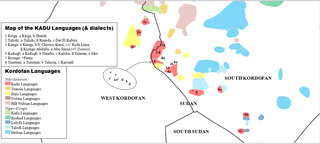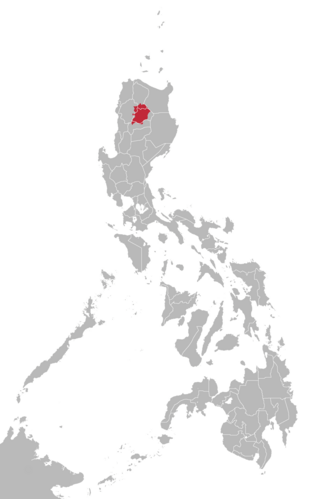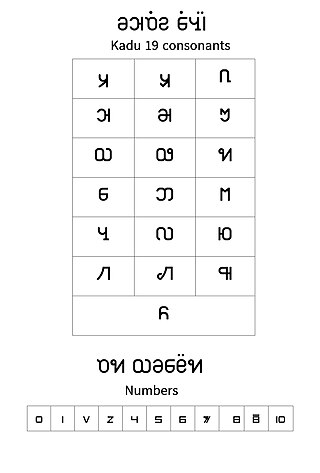Related Research Articles

The Kordofanian languages are a geographic grouping of five language groups spoken in the Nuba Mountains of the South Kordofan region of Sudan: Talodi–Heiban languages, Lafofa languages, Rashad languages, Katla languages and Kadu languages. The first four groups are sometimes regarded as branches of the hypothetical Niger–Congo family, whereas Kadu is now widely seen as a branch of the proposed Nilo-Saharan family.

The Nilo-Saharan languages are a proposed family of African languages spoken by somewhere around 70 million speakers, mainly in the upper parts of the Chari and Nile rivers, including historic Nubia, north of where the two tributaries of the Nile meet. The languages extend through 17 nations in the northern half of Africa: from Algeria to Benin in the west; from Libya to the Democratic Republic of the Congo in the centre; and from Egypt to Tanzania in the east.

The Kadu languages, also known as Kadugli–Krongo or Tumtum, are a small language family of the Kordofanian geographic grouping, once included in Niger–Congo. However, since Thilo Schadeberg (1981), Kadu is widely seen as Nilo-Saharan. Evidence for a Niger-Congo affiliation is rejected, and a Nilo-Saharan relationship is controversial. A conservative classification would treat the Kadu languages as an independent family.

Kalinga is a dialect continuum of Kalinga Province in the Philippines, spoken by the Kalinga people, alongside Ilocano. The Banao Itneg variety is not one of the neighboring Itneg languages.

Kawaimina is a cluster of four languages and dialects of East Timor:

The Nambikwaran languages are a language family of half a dozen languages, all spoken in the state of Mato Grosso in Brazil. They have traditionally been considered dialects of a single language, but at least three of them are mutually unintelligible.
Katcha may refer to:
Tulishi is a Kadu language spoken in South Kordofan. Dialects are Tulishi proper and Kamdang.
Keiga, Yega, or Deiga is a Kadu language spoken in Kordofan. Dialects are Demik (Rofik) and Keiga proper (Aigang).
Kanga is a Nilo-Saharan language of the Kadu branch spoken in South Kordofan, Sudan.

Kadu or Kado(Kadu:); is a Sino-Tibetan language of the Sal branch spoken in Sagaing Region, Myanmar by the Kadu people. Dialects are Settaw, Mawkhwin, and Mawteik [extinct], with 30,000 speakers total. Kadu is considered an endangered language, and is closely related to the Ganan and Sak languages.
Miji, also given the dialect names Sajolang and Dhammai, is a dialect cluster traditionally counted as one of the Sino-Tibetan languages that is spoken in Arunachal Pradesh, northeastern India. The varieties are not particularly close, with only half of the vocabulary in common between the languages of East Kameng District and West Kameng District. Long assumed to be Sino-Tibetan languages, Miji and the recently discovered Bangru language may instead form a small independent language family.
Sak is a Sino-Tibetan language of the Sal branch spoken in Bangladesh and Myanmar by the Chak people.
Khumi, or Khumi Chin, is a Kuki-Chin-Mizo language of Burma, with some speakers across the border in Bangladesh. Khumi shares 75%–87% lexical similarity with Eastern Khumi, and 78-81% similarity with Mro-Khimi.
Karenni or Red Karen, known in Burmese as Kayah, is a Karen dialect continuum spoken by over half a million Kayah people in Burma.
Kayan, also known as, Padaung or Padaung Karen) is a Karen language of Burma, spoken by the Kayan people. The Kayan dialects share more than 90% lexical similarity. Padaung is 71% to 76% lexically similar to Lahta.
Mang, or Mashan Miao also known as Mashan Hmong, is a Miao language of China, spoken primarily in Ziyun Miao and Buyei Autonomous County, southwestern Guizhou province, southwest China. The endonym is Mang, similar to other West Hmongic languages such as Mong.

Nyishi (Kamle) or Sarak is a Tani language of India. It is spoken in Arunachal Pradesh by an estimated 9,000 people of the Nyishi tribe. It appears to be a dialect of the Nishi language.
Ganan is a Sino-Tibetan language of northwestern Myanmar, spoken in Sagaing Region. It belongs to the Luish branch, and is most closely related to the Kadu language of Myanmar, with which it shares 84 to 89% lexical similarity. The Ganan dialects share 95 to 99% lexical similarity.
References
- ↑ Kadugli at Ethnologue (18th ed., 2015) (subscription required)
- ↑ Turner, Darryl (2015). The morphosyntax of Katcha nominals: A Dynamic Syntax account. University of Edinburgh.